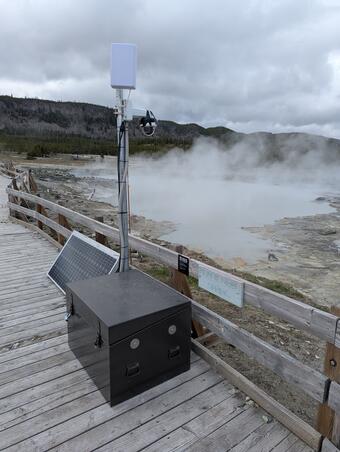A new view of Biscuit Basin (literally!)
YVO is pleased to announce the availability of a new static webcam that provides a current view of Black Diamond Pool in Biscuit Basin—site of a hydrothermal explosion on July 23, 2024.
Yellowstone Caldera Chronicles is a weekly column written by scientists and collaborators of the Yellowstone Volcano Observatory. This week's contribution is from Michael Poland, geophysicist with the U.S. Geological Survey and Scientist-in-Charge of the Yellowstone Volcano Observatory.
On the morning of July 23, 2024, visitors to Biscuit Basin, about 2 miles northeast of Old Faithful Geyser, had to scramble for safety as a hydrothermal explosion occurred from Black Diamond Pool. The plume from the explosion rose 400–600 feet (120–180 meters) into the air, was visible for miles, and threw rocks that destroyed the nearby boardwalk and littered the landscape with debris.
The rock ejected by the explosion was made up of glacial debris, sandstone, and siltstone, all of which are part of the geological deposit that makes up the immediate subsurface. None of the rhyolite bedrock was found, indicating that the explosion was rooted at very shallow levels (probably within 100 feet, or 30 meters, of the surface). Also present in the debris was impermeable silica that was probably lining the hot water conduits feeding Black Diamond Pool. Silica is dissolved in much of the water that feeds Yellowstone hot springs and geysers, and as that water nears the surface and cools, the silica precipitates out as a solid. It can coat the conduits and, because it is impermeable, can seal the system. This can cause pressure to build and might eventually lead to an explosion, like the one that occurred on July 23, 2024.
In the weeks and months following the explosion, scientists from several institutions collaborated to install temporary monitoring stations around Black Diamond Pool, including trail cameras, seismometers, acoustic sensors, and electromagnetic instruments. The cameras often recorded changes—for example, that new rocks had been ejected from the pool—and the seismometers and acoustic sensors detected several dozen eruptions from the pool. Some of the eruptions were associated with surges of water that knocked over seismic nodes and moved them from their original locations or partially buried them in silt.
At least two small eruptions, expelling water, mud, and small rocks 20–30 feet (6–9 meters) into the air, were witnessed since the July 23, 2024, explosion. One occurred on November 5, 2024, while scientists were collecting gas samples. Another took place on January 3, 2025, and was observed by a tour group that was passing by the area.
Since the July 23, 2024, explosion, Biscuit Basin has been closed to public visitation as Yellowstone National Park assesses damage and the potential for future hazardous events. To aid with the assessment, on May 14, 2025, Yellowstone Volcano Observatory scientists installed a new webcam in Biscuit Basin. Static images from the camera are publicly available at https://www.usgs.gov/media/webcams/biscuit-basin-webcam, with images updated every 15 minutes.
The camera is a temporary deployment installed on the damaged boardwalk, so the picture is somewhat tilted due to the slope of the boardwalk itself. Nevertheless, the view of Black Diamond Pool is clear, and the camera has pan, tilt, and zoom capabilities that allow the frame to be adjusted if activity warrants. Because the deployment is not intended to be permanent, the camera might fail due to problems with power or telemetry systems. If this happens, we will work to get the camera back online as soon as possible. The camera is intended to operate at least throughout the summer of 2025, and if warranted may be hardened to last throughout the winter months.
Bandwidth at the site is not sufficient at this time to support live streaming, but video is being recorded on site. If the static images document the occurrence of an event (based on the appearance of new rocks or wet ground, for example), video can be downloaded for analysis. If any such events are captured, we’ll be sure to post video clips to the YVO website.
We hope that this new view is of interest to the public, and we are confident it will provide a new perspective on activity at Black Diamond Pool that will be useful for the ongoing assessment of hazards from the area. Many thanks to Yellowstone National Park for supporting this deployment, which was completed under research permit YELL-2025-SCI-5842.
Biscuit Basin remains closed due to the damaged caused on July 23, 2024, as well as hazards posed by potential future hazardous hydrothermal events. So for those who would like a current close-up view of Black Diamond Pool, check out YVO’s new camera! And stay tuned for more details about the July 23 explosion and subsequent activity as research efforts continue.




